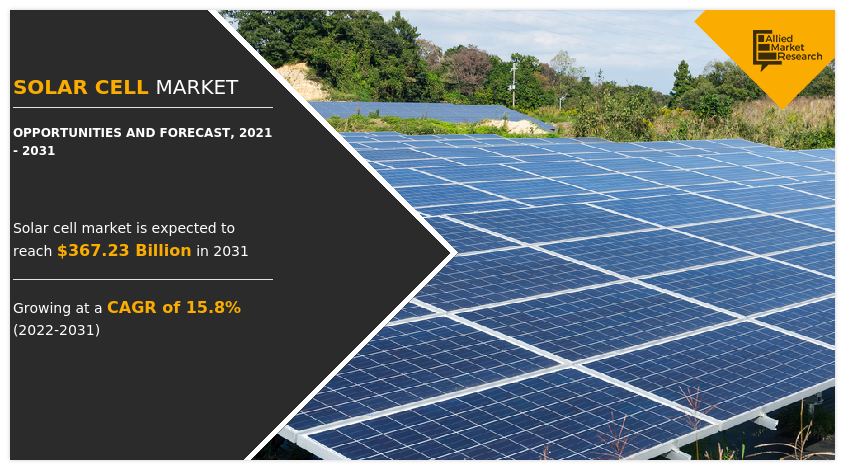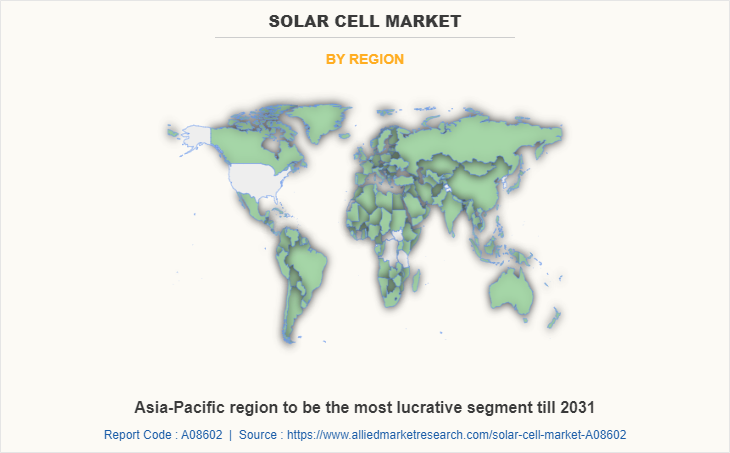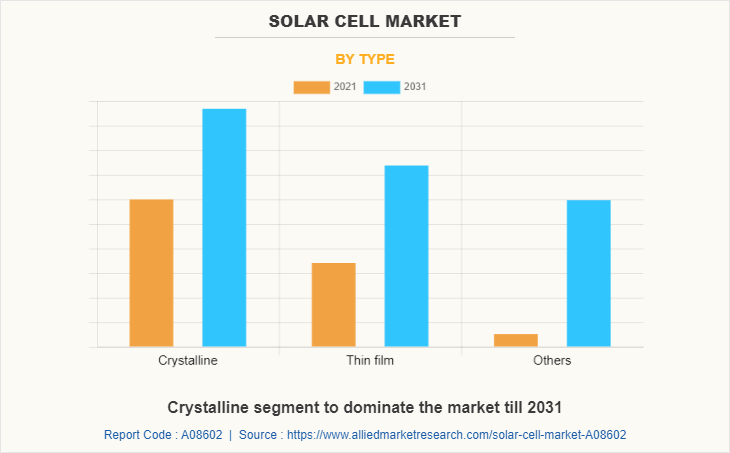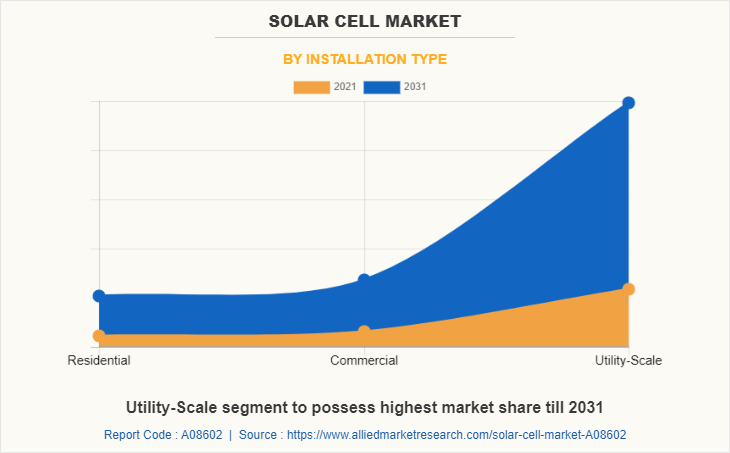Solar Cell Market Research, 2031
The global solar cell market size was valued at $84.91 billion in 2021, and solar cell industry is projected to reach $367.23 billion by 2031, growing at a CAGR of 15.8% from 2022 to 2031.

Solar energy is the energy produced by the radiation of the sun. This energy is transformed into electricity with the help of solar cells. This electricity can then be used in powering electrical equipment, fed into the electricity network for use or stored in a battery. Over the last few years, the solar industry has been developing at a considerable pace, which is attributable to low cost of PV panels and strong presence of solar based power equipment in agricultural sector. Furthermore, awareness toward solar water farming is increasing among consumers, due to implementation of government regulations to promote production of energy from renewable sources to reduce dependency on fossil fuels and to minimize the emission of pollutants. According to the U.S. Solar Energy Industries Association (SEIA), the government has implemented laws such as net metering and community solar, to promote the use of photovoltaic technology to generate electricity.
The growing installations of renewable energy source for power generation across the globe are boosting the demand for solar panel module systems, which in-turn boost the demand for solar cell. The key market players are focusing on improving the disadvantages of the solar panels and lower cost price of PV modules is expected to stimulate the growth of the market. In addition, increase in investment in green energy resources among the developing and developed countries are fueling the solar cell market growth.
Solar power systems play an important role in expansion of energy access in various regions such as South Asia and African countries. The private investors have embraced the standalone products as sustainable solutions for electricity access as these systems offer low management and maintenance costs for the deployment of solar panels, which is expected to boost the solar cell market. Increase in awareness regarding the use of low carbon intensive technologies to mitigate greenhouse gas (GHG) emission will drive the market. Furthermore, the presence of government incentives and reduction in taxes in developing countries promote the use of solar and have a positive impact on the development of the market.
The solar cell market is segmented on the basis of type, installation type and region. On the basis of type, it is segmented into thin film solar cell which is further segmented into CdTe, a-Si, CI(G)S; and crystalline solar cell, which is further segmented into multi-Si, mono-Si; and others. On the basis of installation type, the market is bifurcated into residential, commercial, and utility-scale.
Region wise, the market is studied across North America, Europe, Asia-Pacific, and LAMEA. Presently, Asia-Pacific accounts for the largest solar cell market share of the market, followed by North America and Europe.

Region wise, Asia-Pacific dominates the global solar cell market and is studied across China, Japan, India, South Korea, Thailand, Australia, and rest of Asia-Pacific. In Asia-Pacific, PV energy is widely used in generation of electricity for standalone systems and rural electrification. In addition, growth of telecommunication and aerospace & defense industry has led to increase in usage of PV energy across the Asia-Pacific region. Rapid industrialization and urbanization across countries of Asia-Pacific region such as India, China, and Thailand, have led to increase in infrastructure development activities, including construction of highways and new residential complexes, which are expected to fuel the demand for standalone systems. In addition, photovoltaic panels are used in satellite to generate electricity for smooth functioning of satellite in space. Thus, increase in government investment in R&D of satellite technology for civil and military uses is expected to propel the demand for PV energy. Furthermore, photovoltaic panels are used to generate electricity to power batteries of telecommunication towers to transmit signal to long range. Thus, development and usage of mobile technologies such as 4G and 5G is expected to drive the growth of the Asia-Pacific solar cell market. Furthermore, the boom of green investments in Asia and the ambitious policies in order to dominate the global renewable energy in terms of capacity, technology development, and energy demand. The above mentioned initiatives are major factors driving the growth of the market in this region during the forecast period.

The crystalline type solar cell segment dominates the global solar cell market. Crystalline silicon type solar cell is one of the most widely used semiconductor material in photovoltaic (PV) technology to manufacture solar cells. C-Si occupies more than half of the total solar cell market revenue owing to its several benefits such as improved efficiency. Crystalline silicon solar cell is made of highly pure silicon wafers that are further used to convert the solar energy into electrical energy. Crystalline silicon solar cell market is driven by heightened demand for renewable energy and increase in electricity demand, which is further supported by the rise in population globally. Limited availability of fossil fuels and strict government regulations on carbon emission create the strong need for efficient and cost-effective renewable energy sources such as solar energy. Crystalline silicon solar cells are highly efficient as compared to its rival technologies, for instance, amorphous silicon and non-silicon solar cells. Technological advancements in the field of solar cells to increase efficiency and rise in government spending on renewable energy projects are expected to provide growth opportunities in the market.

The utility-scale segment dominates the global solar cell market. Utility scale solar is large scale solar power plant. A solar power station at a scale large enough to be classified as “utility scale” in comparison with rooftop solar systems. Utility scale refers to electrical plant or equipment, whose operation, as an individual entity would cause a noticeable change in the operation of a utility. It is generating reliable, clean electricity with a stable fuel price for decades. Solar power plants can be developed in a way that balances environmental protection with increase in energy demands and climate goals. The rapid industrialization and decrease in fossil fuel resources across the globe have led to increase in demand for industrial utilization of solar panels. Utility-scale solar can be paired with energy storage to manage evening energy ramps, provide backup power, and more. The presence of above mentioned wide range of utilization of solar cell panels in various industrial and augmented applications is expected to provide numerous opportunities for the market.
The major companies profiled in this report include AAbengoa SA, Acciona SA, Borg Inc., Canadian Solar Inc., First Solar, Green Brilliance, Indosolar Limited, JA Solar Holdings Co. Ltd., Jinkosolar Holdings Co. Ltd., Kaneka Corporation, LG Electronics, LONGi, Solarworld AG, Sharp Corporation, Sunedison Inc., Sunpower Corporation, Tata Power System Limited, Trina Solar, Wuxi Suntech Power Co., Ltd. and Yingli Solar. Due to rapidly development of industrialization, modernization and spread of information through internet led to development of the tourism industry, which in-turn has fuelled the demand for solar cell. Additional growth strategies such as expansion of production capacities, acquisition, partnership and research & innovation in the solar energy application, which led to development in the global solar cell market trends.
COVID-19 analysis:
COVID-19 has severely impacted the global economy with devastating effects on global trade, which has simultaneously affected households, business, financial institution, industrial establishments and infrastructure companies. The novel coronavirus has affected several economies and caused lockdown in many countries, which has limited the growth of the market. The shutdown of industrial manufacturers led to decline in demand for solar related equipment in most of the countries across the world. The decrease in utilization of power in the industrial facilities across the globe during the outbreak has a negative impact on the development of the market.
After the global vaccination, the governments of various countries have taken initiatives to improve the national energy security during these kinds of pandemic situations through increase in investment in the renewable energy related industries, especially solar and wind power systems. Increase in investment is mostly to improve the national energy security during the pandemic and other crisis. The presence of above mentioned activities and change in policies due to outbreak of pandemic have positive impact on the development of the market during the forecast period.
Key Benefits For Stakeholders
- This report provides a quantitative analysis of the market segments, current trends, estimations, and dynamics of the solar cell market analysis from 2021 to 2031 to identify the prevailing solar cell market opportunities.
- The market research is offered along with information related to key drivers, restraints, and opportunities.
- Porter's five forces analysis highlights the potency of buyers and suppliers to enable stakeholders make profit-oriented business decisions and strengthen their supplier-buyer network.
- In-depth analysis of the solar cell market segmentation assists to determine the prevailing market opportunities.
- Major countries in each region are mapped according to their revenue contribution to the global market.
- Market player positioning facilitates benchmarking and provides a clear understanding of the present position of the market players.
- The report includes the analysis of the regional as well as global solar cell market trends, key players, market segments, application areas, and market growth strategies.
Solar Cell Market Report Highlights
| Aspects | Details |
| By Type |
|
| By Installation Type |
|
| By Region |
|
| Key Market Players | Trina Solar Limited, Sharp Corporation, Acciona S.A., Abengoa SE, Tata Power Systems Limited, Kaneka Corporation, First Solar, Inc., SunEdison, Inc., SolarWorld AG, Canadian Solar Inc, Yingli Solar, GreenBrilliance, Indosolar Limited, Borg Inc., SunPower Corporation |
Analyst Review
The global solar cell market is expected to witness increased demand during the forecast period, due to rapidly growing awareness among the people regarding the advantages of the green energy and high efficiency conversion of solar panel.
Solar cell is preferred over other sources of electricity generation, as it requires minimum maintenance and is pollution free. The solar cell market is expected to grow at a rapid pace during the forecast period, owing to increase in demand for electricity and rise in initiatives by government to reduce CO2 emissions. In addition, the solar technology has gained popularity in the recent years, owing to increase in awareness of renewable sources of energy.
The Asia-Pacific solar cell market offers lucrative opportunities for key manufacturers, owing to rapid installation of solar technology to increase renewable energy generation. In addition, China actively enhances its solar power to cope with its pollution demands and to boost its domestic manufacturing industry.
The increase in the demand for electricity from commercial & industrial sectors especially during peak hours is a major market driver. As demand for solar based electricity is increasing across the world, key market players are coming up with latest advanced solar modules focusing on efficiency, cost, and design of the solar panel. The major factor hindering the growth of the market is its huge installation cost.
Supportive government policies and initiatives toward usage of solar cell technology and rise in demand from commercial and utility-scale sectors for electricity are the key factors boosting the solar cell market growth
Increase in demand for solar cell technology in residential applications is the Main Driver of solar cell Market
Abengoa SA, Acciona SA, Borg Inc., Canadian Solar Inc., First Solar, Green Brilliance, Indosolar Limited, JA Solar Holdings Co. Ltd., Jinkosolar Holdings Co. Ltd., Kaneka Corporation, LG Electronics, LONGi, Solarworld AG, Sharp Corporation, Sunedison Inc., Sunpower Corporation, Tata Power System Limited, Trina Solar, Wuxi Suntech Power Co., Ltd. and Yingli Solar
Utility-scale based application is projected to increase the demand for solar cell Market
The global solar cell market is segmented on the basis of type, installation type and region. On the basis of type, it is segmented into thin film solar cell which is further segmented into CdTe, a-Si, CI(G)S; and crystalline solar cell, which is further segmented into multi-Si, mono-Si; and others. On the basis of installation type, the market is bifurcated into residential, commercial, and utility-scale. Region wise, the market is studied across North America, Europe, Asia-Pacific, and LAMEA.
The market value of solar cell 2031 is expected to be $367.23 billion
After the global vaccination, the governments of various countries have taken initiatives to improve the national energy security during these kinds of pandemic situations through increase in investment in the renewable energy related industries, especially solar and wind power systems. Increase in investment is mostly to improve the national energy security during the pandemic and other crisis. The presence of above mentioned activities and change in policies due to outbreak of pandemic have positive impact on the development of the market during the forecast period.
Loading Table Of Content...



